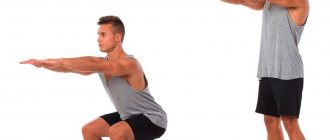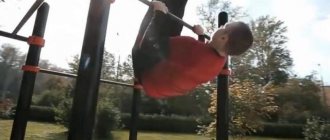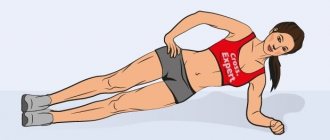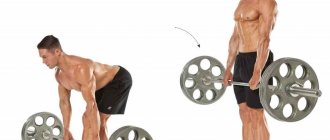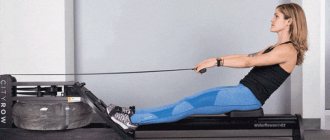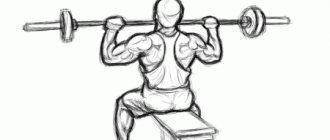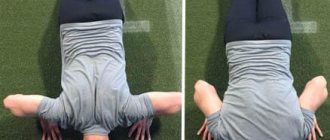Share:
What you need
- Barbell
- Platform
The barbell snatch is a weightlifting exercise that has successfully gained a foothold in CrossFit in our time. Learning the snatch, like any other basic exercise, should begin with minimal working weights and practicing the correct technique, since many aspects of the exercise require special attention. Today we will tell you how to learn how to jerk a barbell correctly.
Ask any professional weightlifter how much time they spent perfecting their snatch technique. The answer will surprise you. Years. Therefore, there is no need to force events, since “fighting gravity,” as Soviet weightlifters aptly put it, is a serious matter.
Today we will try to consider the following features of performing a barbell snatch:
- Why should you perform a barbell snatch?
- Exercise technique
- Typical beginner mistakes
- Sports standards in the snatch and clean and jerk
- How to increase strength in the snatch?
- CrossFit complexes that contain a barbell snatch
Why should you perform a barbell snatch?
Are there any benefits to the barbell snatch? Along with exercises such as the deadlift, bench press and squat, the snatch is a measure of your fitness. It is impossible to remain weak and lift decent weights in these exercises. There is an opinion that the barbell snatch is exclusively a strength exercise and does not contribute to the growth of muscle mass, but this is not entirely true. Look at the figures of weightlifters - they are shaped like an hourglass. Broad shoulders and chest, narrow waist and powerful hips. To me, weightlifters look much more aesthetically pleasing and proportional than powerlifters with big bellies or completely non-functional bodybuilders. Therefore, you should not write off the barbell snatch if your goal is to gain muscle mass, since they put a tremendous load on the hips, buttocks, lower back and all the muscles of the shoulder girdle.
Examples of training with jerks[edit | edit code]
Workout 1 - running backwards
- maximum number of approaches in 12 minutes 15 box jumps
- 15 jerks
- 300 meters running backwards
What are the benefits of running backwards?
Of course, we run backwards slower than the other way around. But this is not a problem for TD, where we repeat the exercises, albeit with increased intensity, but below the maximum. Running backwards is effective
and an original exercise for functional and amazing results in the development of the muscles of the posterior region. In addition, this exercise allows you to systematically start the movement from the forefoot, thus reducing the impact on the ground and developing the sensitivity of the muscle receptors of the foot
Workout 2 – “explosive”, but not painful
- minute start for 20 minutes 50m sprint
- 4 jerks
- 6 burpees
Training 3 - “reveals the truth”
- 17 minutes to find your maximum in the deadlift, squat and snatch. Time and exercise management is completely at your discretion
Of course, you should strive for the highest results
Correct snatch technique
Maintaining the correct technique in the barbell snatch provides you with consistently good progress in working weights. But be prepared that this will take time. If you work out in a regular fitness club with a personal trainer, and he says that he will teach you the snatch technique in one workout, this is a huge reason to think about his competence. Seriously. Think about who you trust with your health and athletic longevity.
The barbell snatch is an explosive and dynamic exercise and requires the athlete performing it to have a good stretch. If your movements are constrained, it is unlikely that anything will come of it. Therefore, I recommend starting every workout in which you perform a snatch with a thorough warm-up and stretching. Use both static (medium effort, 30-60 seconds) and dynamic (powerful effort, 5-10 seconds) variations of stretching.
The greatest attention should be paid to stretching the quadriceps, hamstrings and hip adductors. To do this, you can use the following simple exercises: transverse and longitudinal splits, deep squats with a pause at the bottom point, deadlifts on straight legs, bending over with a barbell on the shoulders, lunges with a pause at the bottom point. Use the well-known bridge exercise to properly stretch and prepare your abdominal muscles for work. A couple of approaches of hanging on the bar will also be extremely beneficial - hypertonicity will go away from the spinal extensors, and the static tension of the hands and forearms will give you greater control over the bar when performing a snatch.
How to learn to do a barbell snatch? The exercise can be divided into the following stages: tearing the bar off the floor, lifting it, squatting, getting up from the squat, fixing. Let's start in order:
© artem1 — stock.adobe.com
The barbell comes off the floor
Starting position:
- Feet shoulder width apart.
- Hands are spread as wide as possible.
- The toes are spread slightly to the sides, the center of gravity lies on the heels.
- We keep our back straight, while maintaining a natural arch in the lumbar region.
- The shoulders are laid back slightly, the gaze is directed straight ahead.
In order to minimize the likelihood of dropping the barbell from your hands, we recommend using a lock grip. Our task is to lift the barbell off the floor with a powerful force and give it the necessary acceleration in order to fix it above your head. Weightlifters practice the first stage of the snatch separately and call it the “snatch deadlift.” Essentially, this is a wide-arm variation of the deadlift that allows for a longer range of motion due to the lift. So, we lift the barbell off the floor using the force of our legs and back, while keeping our back straight. Raise it just above the knee, while the bar should be as close to the shin as possible.
Detonation
Now our task is to set the required acceleration. As soon as the barbell is just above the knees, we straighten our legs, straighten our body and stand up a little on our toes without bending our arms. The bar should “fly” up.
Podsed
As soon as the barbell begins to “take off”, you need to perform a squat. The key point here is not to be late. You need to sit under the bar when it is just gaining height, when it is already starting to slow down, it is almost impossible to do this. To work in a more comfortable amplitude when squatting and to make getting up a little easier, it is recommended to use weights.
Rising from a squat
If everything is done correctly, the barbell “flies” vertically above you on straight arms, your pelvis is pulled back, and your hamstrings rest on your calf muscles. We stand up in the same way as with classic or front squats with a barbell. Don’t forget about a straight back and try to control the barbell with your hands. If you are slightly outweighed and pulled forward, you will drop the barbell from your hands or fall.
Fixation
When we get up from the squat, our task is to lock ourselves with the barbell in a stationary position. It is necessary to hold the barbell and not let it overwhelm you; to do this, we statically strain the triceps. After a second pause, you can throw the barbell on the floor - this is perhaps the most pleasant moment in the exercise.
Video about the barbell snatch technique, a shortened and understandable version with slow motion repetition:
Detailed video about barbell snatch training – how it goes:
The snatch technique is described in great detail in the video:
Determining the width of the snatch grip
Before learning all snatch exercises, determine your individual grip width.
Take a wide-grip PVC pipe, which is available in any TA gym. Raise it above your head. Lower either arm so that it is parallel to the floor.
The second hand should look straight up. The angle between the hands is 90 degrees. The pipe and two hands should form a right triangle.
Without changing the position of your hands, bring the pipe to the bar and remember the place of your snatch grip.
Initial position
The exercise begins not from the floor, but from the position of the barbell in your hands.
- Grasp the barbell with a snatch grip.
- Perform a deadlift and stand up to your full height.
- Squeeze your shoulder blades together, chest facing forward.
- Arch your lower back and keep it tight throughout the entire movement.
- The bar touches the lower abdomen near the pubic bone
Common mistakes
Next, we will analyze the typical mistakes of beginners when performing a barbell snatch from the floor.
- Too much weight. Believe me, your strength records are worth absolutely nothing if you do not follow the correct technique for performing the exercise and put your health at risk.
- Wrong choice of coach. It's no secret that most of your sporting success depends on the competence of your coach. If you are seriously interested in CrossFit or weightlifting, choose a suitable trainer, since it will be extremely difficult to independently study elements such as the snatch and clean and jerk, and it is a competent specialist who will help you establish the correct technique and achieve results.
Rise from the main start to the explosion
After the kettlebell begins its return movement from the main start ( frame 1 ), you need to start moving your pelvis and knees forward, as if slightly ahead of the movement of the kettlebell, thereby giving the weight an initial acceleration ( frame 2 ). At the same time, the overall center of gravity smoothly shifts closer to the toes
After passing the weights of your knees, begin to squeeze your buttocks and straighten your legs (open up). And, as if to counterbalance the weights, tilt the body a little back ( frame 3 ).
You can read more about this part of the movement in the article by Sergei Rudnev - Kettlebell swings, types of swings and execution technique.
Weightlifting Standards
Below are the official weightlifting standards for 2016, approved by the Russian Weightlifting Federation. If you have already achieved certain results and meet some standard, feel free to apply for regional competitions and confirm it!
Table of rank standards for men (sum of double event: clean and jerk + snatch, kg).
| Weight category (kilogram) | MSMK | MS | KMS | I | II | III | I(yu) | II(yu) | III(ju) |
| 34 | – | – | – | – | – | – | 75 | 70 | 55 |
| 38 | – | – | – | – | – | – | 80 | 75 | 60 |
| 42 | – | – | – | – | 105 | 95 | 85 | 80 | 65 |
| 46 | – | – | 135 | 120 | 105 | 95 | 90 | 85 | 70 |
| 50 | – | 180 | 155 | 135 | 120 | 105 | 95 | 90 | 75 |
| 56 | 255 | 205 | 175 | 155 | 135 | 120 | 100 | 95 | 80 |
| 62 | 285 | 230 | 195 | 175 | 155 | 130 | 110 | 100 | 85 |
| 69 | 315 | 255 | 210 | 185 | 165 | 140 | 125 | 110 | 95 |
| 69+ | – | – | – | 195 | 175 | 150 | 135 | 115 | 105 |
| 77 | 350 | 280 | 240 | 210 | 185 | 160 | 140 | 125 | 110 |
| 85 | 365 | 295 | 255 | 225 | 195 | 170 | 145 | 130 | 115 |
| 94 | 385 | 310 | 265 | 230 | 200 | 175 | 155 | 135 | 120 |
| 94+ | – | 315 | 270 | 235 | 210 | 180 | 160 | 140 | 125 |
| 105 | 400 | 320 | 275 | 240 | 215 | 185 | – | – | – |
| 105+ | 415 | 325 | 280 | 245 | 220 | 190 | – | – | – |
Table of rank standards for women (sum of double event: clean and jerk + snatch, kg).
| Weight category (kilogram) | MSMK | MS | KMS | I | II | III | I(yu) | II(yu) | III(ju) |
| 34 | – | – | – | – | – | – | 65 | 55 | 45 |
| 36 | – | – | – | – | – | – | 70 | 60 | 50 |
| 40 | – | – | 95 | 90 | 85 | 80 | 75 | 65 | 55 |
| 44 | – | 120 | 105 | 95 | 90 | 85 | 80 | 70 | 60 |
| 48 | 165 | 130 | 110 | 100 | 95 | 90 | 85 | 75 | 65 |
| 53 | 180 | 140 | 120 | 110 | 105 | 95 | 90 | 80 | 70 |
| 58 | 190 | 150 | 130 | 115 | 110 | 100 | 95 | 85 | 75 |
| 63 | 205 | 160 | 140 | 125 | 115 | 105 | 100 | 90 | 80 |
| 69 | 215 | 170 | 150 | 130 | 120 | 110 | 105 | 95 | 85 |
| 69+ | – | 175 | 155 | 135 | 125 | 115 | 110 | 100 | 90 |
| 75 | 225 | 180 | 160 | 140 | 130 | 120 | – | – | – |
| 75+ | 235 | 190 | 165 | 145 | 135 | 125 | – | – | – |
Resetting the weight from the fixed position
After fixing the weight on your straightened arm, you need to rotate the weight around your forearm, move your arm forward, slightly bending it at the elbow, and tilt your body back slightly ( frame 7 ). After this, immediately at head level, you need to intercept the bow with an overhand grip ( frame 8 ), slightly raise your shoulder and stand on your toes. And starting from this moment, begin to reduce the speed of the weight. At the moment when the arm becomes tense from the weight, you need to slightly extinguish the twitching movement by lowering the shoulder and begin to bend a little at the knees ( frame 9 ).
How to increase strength in the snatch?
How to improve the result of a barbell snatch if the weight does not increase? The snatch is a technically difficult exercise that requires delicate technique and powerful mental concentration, so standard schemes used in powerlifting, such as 5x5, are unlikely to help here. As with any exercise that involves lifting a barbell from the floor, progress is achieved by practicing individual phases of the movement. Therefore, in order to become stronger in the snatch, you need to become stronger in overhead squats, snatch lifts, deadlifts, snatch grip pulls, and other accessory exercises.
As for the progression of loads, you can turn to percentages developed by Boris Ivanovich Sheiko. And even though Sheiko specialized in powerlifting, his methods are suitable for any strength sport.
Recipes for healthy eating
Mashed Potatoes with Bacon
- 3.6 g Protein
- 3.4 g Fat
- 14.7 g Carbohydrates
- 110.2 kcal
40-55 min.
- #bacon
- #second course
- #dietary
- #baking
- #greenery
- #potato
- #milk
- #low calorie
- #dinner
- #butter
- #dinner
Other recipes
Examples of training with jerks[edit | edit code]
Workout 1 - Burpee Snatches
- 10 episodes with minute start
- 3 hip jerks 65%
- 6 burpees
- 4 minutes rest
- 3 x 1 minute run, run as tightly as a long distance. 2 minutes of maximum active recovery.
Workout 2 - Lasting Power
- 1 snatch + 1 snatch squat every minute for 15 minutes
Then squats + burles: 10-8-6-4-2 reps each as quickly as possible.
Workout 3 - Pull in all directions
- squats 3 x 5, then 3 x 3
- 10 hip jerks - 10 pull-ups.
As many times as possible in 12 minutes.
Variations of the exercise
You can perform a jerk in different ways:
Option 1. Experienced athletes with good physical training can do a more complicated snatch. when it is carried out without involving the legs, but solely by the strength of the back muscles. This becomes possible, for example, when sitting on a chair, which does not allow the use of the lower limbs.
Option 2. Involves using two shells at once. They can rise either simultaneously or in turn on each hand.
You should understand the difference between a jerk and a pull. The latter is not performed through inertia, which allows the weight to fly up, but is carried out through muscle effort. This is a completely different exercise.
Combination of options
The “stand-up jerk” technique requires considerable effort and endurance, but thanks to additions and combinations of different types, you can choose the best option for yourself. Experts advise performing the load in 1-3 repetitions over several approaches.
If you have experience, the number of repetitions increases to enhance effectiveness. To develop execution speed and power, the weight must be large; if we are talking about working out individual muscle groups, then the load should be lighter. For a lighter workout, choose a weight that is 30% lighter than the athlete’s usual weight. This load is enough to create muscle statics and produce lactic acid. You can perform several types of jerks during one workout to get maximum effect.
Three-cycle breathing
The most effective is three-cycle breathing. During the ascent from the main start ( frame 1 ) to the explosion ( frame 3 ), inhale . Inhalation smoothly begins simultaneously with the beginning of the movement of the weight and ends at the lift. After this, when the body is fully straightened and opened, the exhalation ( frame 3 ). After undermining and lifting the shoulder up, the chest opens completely and a fairly rapid inhalation ( frame 4 ). During the squat and fixation of the weight at the top, an exhalation ( frame 6 ). inhalation occurs ( frame 7, 8 ). Simultaneously with the interception of the bow into an overhand grip ( frame 8 ) until the arm straightens and the shoulder drops ( frame 9 exhalation occurs .
In this case, depending on the tempo, you can do several breathing cycles when the weight is at the top in the fixation position. The advantages of three-cycle breathing are that this method provides the body with oxygen for the longest time. Also, this method is most successfully combined with movements.
Two-cycle breathing
In two-cyclic breathing, the first two breathing cycles are replaced by one. At the beginning of the movement of the weight from the main start, inhale ( frame 1 ), in the position of fixing the weight at the top, exhale ( frame 6 ). Used to increase speed on lightweight weights.
If you still have questions about technology, you can ask them below in the comments. The main mistakes in the kettlebell snatch and their corrections will be discussed in another article. To better understand what you read, you can watch a video of the jerk in slow motion. Here we use a variant of the snatch without squatting in the fixed position.

